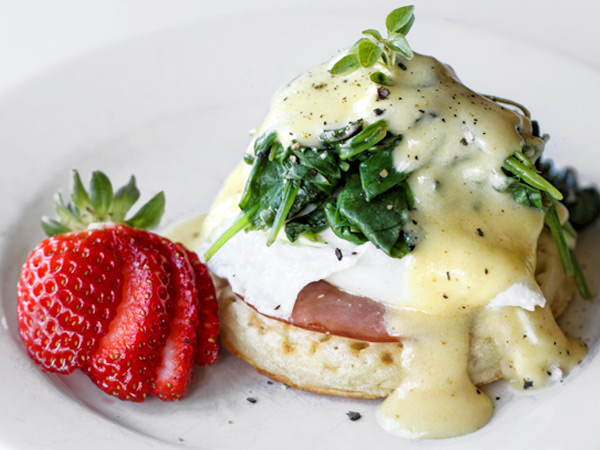 Methods & Madness… Class 5: Dairy & Eggs
Methods & Madness… Class 5: Dairy & Eggs
Recipes & Ramblings from Chef School
This week’s class was jam-packed full of information about dairy and eggs. We learned all about milk, cream, butter, cheese, hollandaise sauce and eggs. We tasted some fabulous cheeses and cooked up some eggs-traordinary dishes.
So not to double up on information please read Rona’s blog for the basics. She covered all that we learned and still managed to make it funny. I will be writing this blog from a historical & fun facts angle.
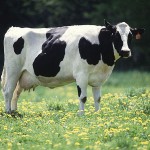 Distinguished Dairy
Distinguished Dairy
We will start with the food that we all began our lives with… milk. It is one of the most versatile foods. Milk is on average 87% water, 5% milk sugar (lactose) and the rest fat, protein, and minerals.
What are the different kinds of milk?
- Pasteurized – milk that has been heated to a temperature between 140-160 degrees to kill any potentially dangerous bacteria. Unfortunately, it kills the good bacteria as well.
- Unpasteurized – also known as raw milk. Europeans swear by it. Canadians, Australians, and 28 U.S. States have banned the sale of it. I grew up drinking raw milk and I turned out ok. Wait a minute… this could explain some things!
If you want to know more in detail about other types of milk such as homogenized, UHT, dried milk, evaporated and condensed CLICK HERE to read a great article by MM Del Rosario.
Holy cow… did you know?
- It used to take a person 1 hour to milk 6 cows by hand. Today, a person can milk 100 cows in an hour with modern machines.
- Average U.S. cow produces 90 glasses of milk each day.
- Milk is the official state beverage of 20 states; here in California it’s wine.
Cream of the Crop
Cream is the fat that rises to the top of whole milk. It has to be at least 20% fat to be called cream. We learned about the differences of fat in cream and what each cream’s function is.
I was excited to learn how easy it is to make one of my favorite creams – Creme Fraiche (krem fresh). It is a thick and smooth heavy cream with a nutty and slightly sour taste. Much better than sour cream in my book. It is so simple to make at home.
Make your own Creme Fraiche
Simply combine 1 cup heavy cream with 1 tablespoon buttermilk and stir. Allow the mixture to stand in a warm place, loosely covered with a towel until thickened but still pourable. This can take anywhere from 8 to 36 hours but taste every 6 hours. It is ready when it is thick. Refrigerate. Will keep up to a week in the refrigerator.
For a comprehensive overview of cream, check out JoyofBaking.com.
Big cheese
Cheese is one of the oldest of made foods. The earliest records come from cave paintings in the Libyan Sahara dating from 5000 B.C. Traces of actual cheese have been found in an Egyptian tomb around 3000 B.C. Source: The Oxnard Companion of Food
Cheese is basically curdled milk of sheep, goats, cows, or other mammals. The distinction between true cheese and things like cream cheese, creme fraiche, etc. is the way in which the milk is curdled. Milk can be curdled either by acid and/or by rennet.
My mother believes no meal is complete without cheese. She is not alone. Americans consumed an average of 31 lbs. of cheese per person per year. The largest consumer is Greece with approx. 63 lbs., followed by France with 54 lbs.
Blessed are the cheesemakers…
There are over 2000 varieties for cheese makers to choose from. With so many cheeses, the taste ranges from mild to extremely strong/stinky.
The fat ranges from 1% to 75%. The lowest being Schabziger – a hard, green cheese with a strong flavor from Switzerland (no, not the moon). The highest being Brillat-Savarin – a triple cream, cow milk brie with a luscious & faintly sour flavor from France.
Cheese bites
Our selection of cheese in class came from The Cheese Store of Beverly Hills and featured a few classics.
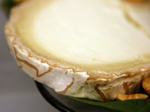
Bucherondin de Chèvre – is a soft, but semi-firm in texture goat milk cheese that is a native of Loire Valley in France.
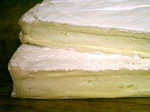 Brie de Meaux – is the first brie ever made. Brie is considered the French cheese’s king of kings. The flavor is nutty and complex with wild mushroom nuances.
Brie de Meaux – is the first brie ever made. Brie is considered the French cheese’s king of kings. The flavor is nutty and complex with wild mushroom nuances.
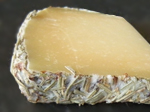 Romao – is a dry, salty and tangy Spanish cheese rubbed in olive oil and rolled in rosemary. This cheese would be an interesting Parmesan substitute.
Romao – is a dry, salty and tangy Spanish cheese rubbed in olive oil and rolled in rosemary. This cheese would be an interesting Parmesan substitute.
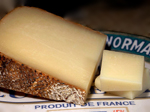 Abbaye de Belloc – this French unpasteurized hard sheep cheese was first made by the Benedictine monks of the Abbaye de Notre-Dame de Belloc. It is firm and dense, yet still creamy and the flavor is rich, buttery, nutty, and fruity with hints of caramel.
Abbaye de Belloc – this French unpasteurized hard sheep cheese was first made by the Benedictine monks of the Abbaye de Notre-Dame de Belloc. It is firm and dense, yet still creamy and the flavor is rich, buttery, nutty, and fruity with hints of caramel.
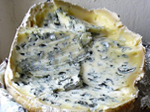 Fourme d’Ambert – is a soft, mild blue that is slightly creamy and very spreadable. It is one of France’s oldest cheeses, and dates from as far back as Roman times.
Fourme d’Ambert – is a soft, mild blue that is slightly creamy and very spreadable. It is one of France’s oldest cheeses, and dates from as far back as Roman times.
If there were only 1 cheese left on the planet, I would want it to be a sweet, fresh cheese called Burrata.
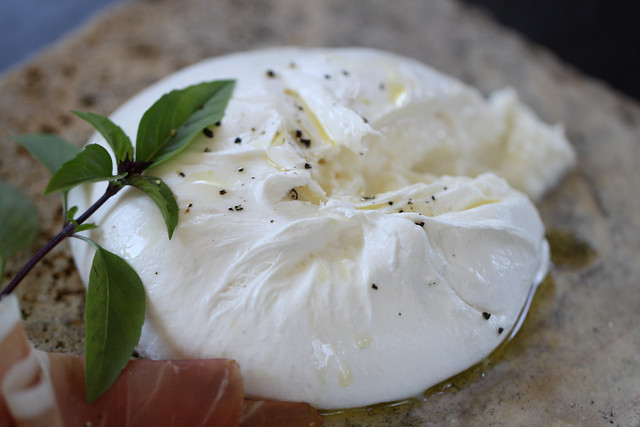
The outer shell is solid mozzarella while the soft buttery inside contains both mozzarella and cream. Yum! I love it with fresh heirloom tomatoes and prosciutto.
Some day when I am feeling like a culinary rock star I will make my own Burrata with these simple instructions.
Now Rona is a goat cheese girl. She likes them all.
My favorite is a creamy and tangy goat milk cheese called Humboldt Fog. This local cheese is made in Arcata, California.
Behold the power of cheese
- Relieves stress and induces sleep
- Help prevent tooth decay
- High concentration of essential nutrients including proteins and calcium
- Reduce problems associated with PMS.
- It makes my mother very happy… and that makes me happy.
Cheesy thoughts to ponder
If cheese is made from animal milk… and we know milk isn’t yellow… but we know how yellow snow is made… should we be concerned?
Originally, cheese could be different shades depending on when it was made and what the cows had eaten. In the spring and summer, cows eat fresh grass and other plants that contained beta-carotene and vitamin D. This results in yellow cheese. In the winter, cows eat hay instead, so the cheese is pale.
Engaging Eggs
Last but not least, we learned about another kitchen marvel… the egg. They are one of nature’s most perfectly balanced foods, containing all the protein, vitamins (except vitamin C) and minerals essential for good health. All that for only 71 calories! The edible part of a chicken’s egg is approximately 74% water, 12% protein, and 11% fat.
According to chefs and professional cooks, there are over 100 ways to cook eggs. The simplest ways to cook eggs can be divided into four categories: frying, scrambling, boiling, and baking.
We also learned how to scramble, fry, poach, and make a French omelet.
Rona explains the egg-cellent techniques on her blog CLICK HERE to read.
Cracking Up
- The older a hen gets, the larger her eggs become. Hmmm… sounds like my thighs.
- A hen can lay about 250 eggs per year.
- Hens with white earlobes produce white eggs, and hens with red earlobes produce brown eggs.
Classroom Assignment:
In class we each made a cheese soufflé. It was surprisingly easy and tasted oh so good.
Egg whites whipped into a stiff peak and gently folding in the egg whites are essential for a good soufflé. CLICK HERE for the recipe.
We also poached an egg and made hollandaise sauce.
For my homework, I chose to make Eggs Florentine. It was a lot of work but worth every bit of the effort. I added the Canadian Bacon. I would like to egg you on to try this scrumptious recipe.
Eggs Florentine
From New School of Cooking
Serves 6
Ingredients
- 6 English muffins ( I used crumpets)
- 1 lb. spinach washed & dried
- Olive oil for sautéing spinach
- 12 poached eggs
- 1 recipe for Hollandaise Sauce – see below
- Canadian Bacon – optional
- Butter – optional
- Chives for garnish – optional
Preparation
- Sauté the spinach in a small amount of olive oil until just limp. Season with salt and pepper and set aside.
- Poach the eggs, set aside.
- Make the Hollandaise sauce.
- Toast and butter the English muffins.
- Meanwhile, reheat the eggs if necessary. Distribute the spinach between the English muffin halves. Sauce with the Hollandaise. Garnish with chives.
Hollandaise Sauce
- 1 cup clarified butter or melted butter
- 3 egg yolks
- 3 T. water
- Lemon juice to taste
- Salt and cayenne pepper
Directions
- Whisk egg yolks and water together in a stainless steel bowl.
- Gently heat over a barely simmering bain marie (water bath), whisking constantly, until eggs are thick. (don’t let the water boil)
- Beat the sauce briskly with a wire whisk as you slowly pour in the butter.
- When all the butter has been added, check consistency and season with lemon juice, salt and a small amount of cayenne.
If you are short of time, you can try this quick blender version.
Leftover sauce can also be served on vegetables or fish.
“A true friend is someone who thinks that you are a good egg even though he knows that you are slightly cracked” – Bernard Meltzer
So here’s to imperfection!
…and then, she paused for thought
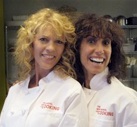 Hope you have enjoyed our adventure in the culinary classroom. Join us each week as we continue learning new culinary skills.
Hope you have enjoyed our adventure in the culinary classroom. Join us each week as we continue learning new culinary skills.
You can also read about Rona’s experience on her blog or What’s Cookin online magazine.
Yum
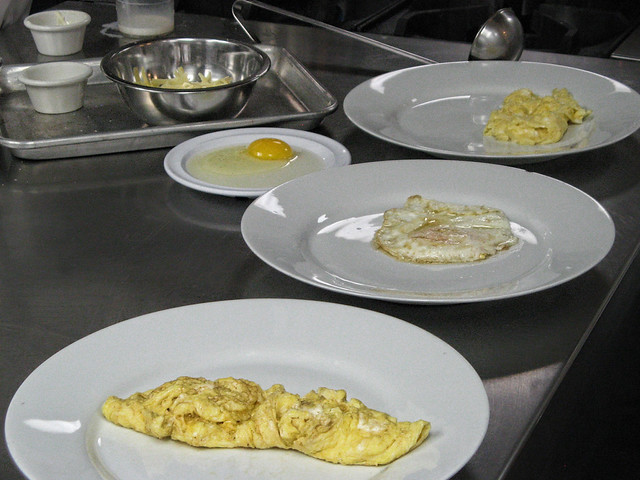
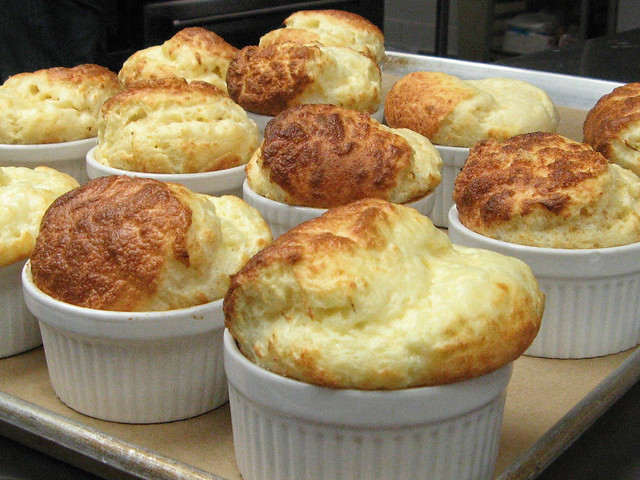
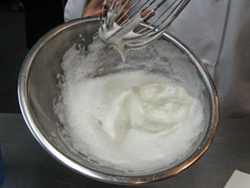

If I have nothing else in my refrigerator, I always have goat cheese. However, I will NEVER have blue-veined cheese with mold going through it. That cuts at least 400 kinds out of the 2000 versions of cheese out there. More for you, my friend!
I will be happy to eat your portion of blue moldy cheese! The stinkier the better. I wonder if this is why I don’t have very many friends! 🙂
thats exactly why….
just razzin ya!
Cathy — would it sound overly emotional if I said I have tears of joy when I read your cooking class adventures??? I’m just so excited you are getting to learn all this in-depth cooking art and having so much fun doing it. I have never dared a cheese souffle but you might just give me the courage to try. I made Canadian Bacon Potato Cheese soup for dinner tonight – hubby and kids were very happy (and they didn’t realize I sneaked and put six cups of shredded zucchini in it to beef up the veggie content). I wil be thinking of you when I visit our family in Iowa next week! Love&Hugs
Thanks Julie! Souffle is easier than it looks.
Your soup sounds fabulous.
Have a great time in Iowa.
Again, I love your blog! Keep up the good work.
🙂
Thank you Nan. I appreciate it.